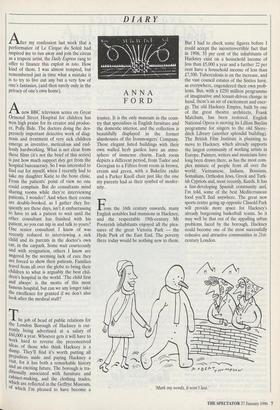DIARY
ANNA FORD After my confession last week that a performance of Le Cirque du Soleil had inspired me to run away and join the circus as a trapeze artist, the Daily Express rang to offer to finance this exploit in toto. How kind of them. I was almost tempted, but remembered just in time what a mistake it is to try to live out any but a very few of one's fantasies, (and then surely only in the privacy of one's own home).
Anew BBC television series on Great Ormond Street Hospital for children has won high praise for its creator and produc- er, Polly Bide. The doctors doing the des- perately important detective work of diag- nosis and treatment of very sick children emerge as inventive, meticulous and end- lessly hardworking. What is not clear from these films (it's not the brief of this series) is just how much support they get from the hospital bureaucracy. So I was interested to find out for myself, when I recently had to take my daughter Katie to the bone clinic. From the patients' point of view no one could complain. But do consultants mind sharing rooms while they're interviewing patients, I wonder? And when their rooms are double-booked, as I gather they fre- quently are these days, isn't it embarrassing to have to ask a patient to wait until the other consultant has finished with his patient, so you can nip in and talk to yours? One senior consultant I know of was recently reduced to interviewing a sick child and its parents in the doctor's own car, in the carpark. Some wait courteously and with resignation, others I know are angered by the seeming lack of care they are forced to show their patients. Families travel from all over the globe to bring their children to what is arguably the best chil- dren's hospital in the world. 'The child first and always' is the motto of this most famous hospital, but can we any longer take the excellence for granted if we don't also look after the medical staff?
The job of head of public relations for the London Borough of Hackney is cur- rently being advertised at a salary of £60,000 a year. Whoever gets it will have to work hard to reverse the preconceived ideas of those who think Hackney is a dump. They'll find it's worth putting all prejudices aside and paying Hackney a visit, for it has both a remarkable history and an exciting future. The borough is tra- ditionally associated with furniture and cabinet-making, and the clothing trades, which are reflected in the Geffrye Museum, of which I'm pleased to have become a trustee. It is the only museum in the coun- try that specialises in English furniture and the domestic interior, and the collection is beautifully displayed in the former almshouses of the Ironmongers' Company. These elegant listed buildings with their own walled herb garden have an atmo- sphere of immense charm. Each room depicts a different period, from Tudor and Georgian to a Fifties front room in brown, cream and green, with a Bakelite radio and a Parker Knoll chair just like the one my parents had as their symbol of moder- nity.
From the 16th century onwards, many English notables had mansions in Hackney, and the respectable 19th-century Mr Pooterish inhabitants enjoyed all the plea- sures of the great Victoria Park — the Hyde Park of the East End. The poverty there today would be nothing new to them. But I had to check some figures before I could accept the incontrovertible fact that in 1996, 33 per cent of the inhabitants of Hackney exist on a household income of less than £5,000 a year and a further 22 per cent have a household income of less than £7,500. Tuberculosis is on the increase, and the vast council estates of the Sixties have, as everywhere, engendered their own prob- lems. But, with a £250 million programme of imaginative and tenant-driven change in hand, there's an air of excitement and ener- gy. The old Hackney Empire, built by one of the great theatre architects, Frank Matcham, has been restored. English National Opera is moving its Lillian Bayliss programme for singers to the old Shore- ditch Library (another splendid building). The British Film Institute is planning to move to Hackney, which already supports the largest community of working artists in Europe. Painters, writers and musicians have long been drawn there, as has the most com- plex mixture of people from all over the world: Vietnamese, Indians, Bosnians, Somalians, Orthodox Jews, Greek and Turk- ish Cypriots and, most recently, Kurds. It has a fast-developing Spanish community and, I'm told, some of the best Mediterranean food you'll find anywhere. The great new sports centre going up opposite Clissold Park will provide more space for Hackney's already burgeoning basketball teams. So it may well be that out of the appalling urban problems faced by the borough, Hackney could become one of the most successfully cohesive and attractive communities in 21st- century London.
Mark my words, it won't last.'


























































 Previous page
Previous page